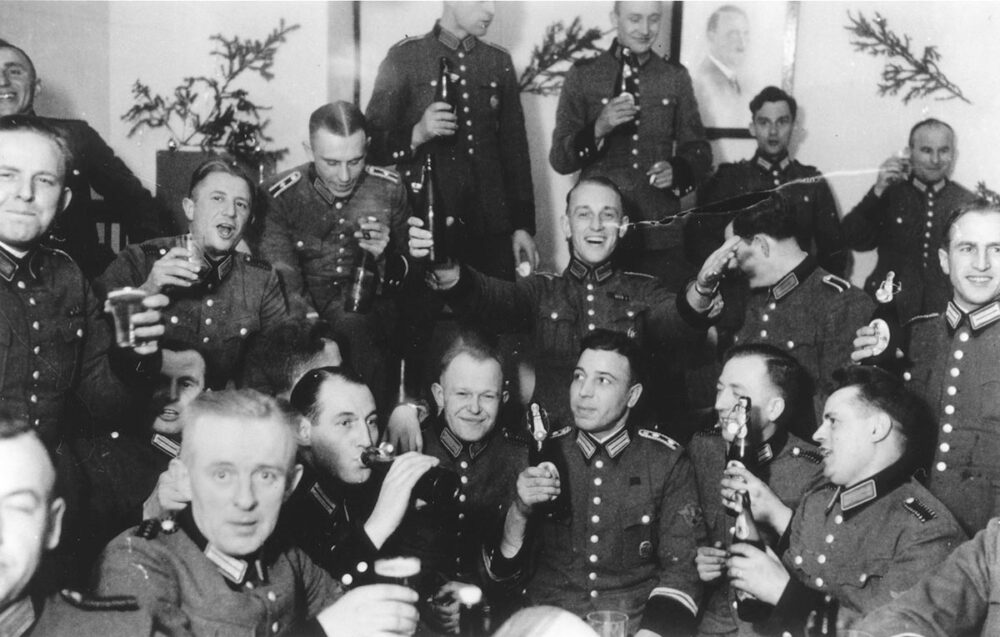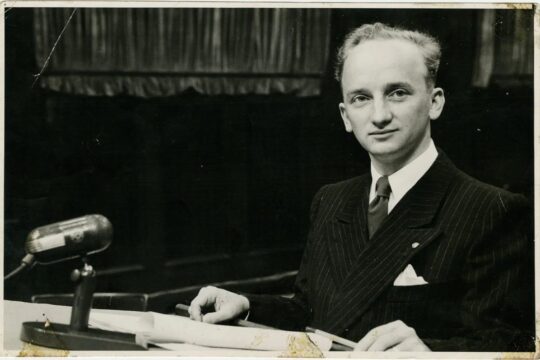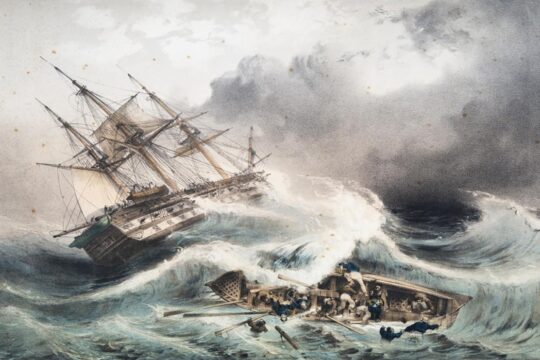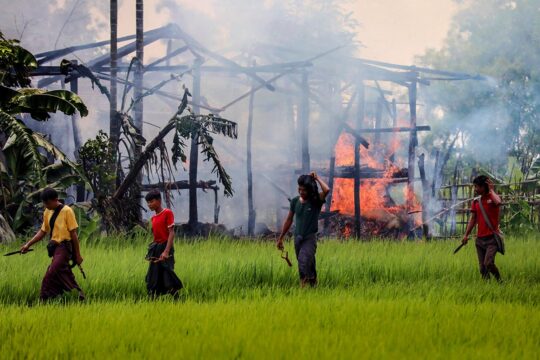Alette Smeulers stands next to the bookcase that covers the wall of her living room, where she receives us in her comfortable house in Groningen, a city in the north of The Netherlands. “You are now looking at the section on the Holocaust,” says the professor of international crimes at the University of Groningen. The black shelves carry hundreds of books about perpetrators, wars and conflicts. Her new book, “Perpetrators of Mass Atrocities”, lies on the table. The result of thirty years of research into perpetrators of large-scale violence such as war criminals, genocidaires and terrorists. She drinks her coffee from a mug that has the words “Terribly and Terrifyingly Normal?” printed on it. The text is the subtitle of her book and the name of the podcast which she produces together with her son.
Smeulers focusses on the dark side of humanity. It started in her childhood, when she read novels about resistance fighters during the Second World War. “My childhood heroes,” she says. This inevitably led to the question she posed herself: but who wants to be a Nazi? As a criminologist specialized in international criminal law, she came to focus on how people become perpetrators. As she was researching Smeulers started to give the uncomfortable answers during public presentations, lectures at university, and now also in her book.
“It’s a process”
“The biggest mistake we can make is to think that a perpetrator is completely different from ourselves. Research shows that we are all potentially capable of committing atrocities. If the circumstances are as such, we can become perpetrators. Not because we are devilish, but because we are weak,” Smeulers explains. While reading scientific literature on the subject, drawing on psychology, law, sociology, political science, history and biographies, she unraveled how people think and act in times of authoritarian regimes and wars. “It is a process in which we go with the flow. We don’t dare to say ‘no’, because we don’t want to be outside the group,” she says. Step by step people go further. “It is small choices that transform people into perpetrators. A gradual process that leads us to evil”, Smeulers says.
These questions have always been acute and present. “But now more than ever. With the Russian invasion of Ukraine. And even more extremely with the war between Israel and Hamas,” she says. Currently Smeulers is studying Israeli Prime Minister Benyamin Netanyahu. “It’s not a compliment when I read someone’s biography,” she smiles. “Of course, he has the right to protect his country against groups that want to destroy Israel. But he doesn’t make sufficient distinction between the extremists and ordinary Palestinians.”
Typology
Smeulers looks at the large sheet of paper in front of her with the overview of fourteen perpetrator types that she developed. “We should not lump all perpetrators together. There are enormous differences. Also, not everyone can become every kind of perpetrator.”
1. The “criminal mastermind”. These powerful top leaders are crucial because they run the atrocity system. They are strong-willed, generally believe in their superiority, feel themselves above the law and are ruthless in gaining and maintaining power. “They develop the policies and give - sometimes explicit, sometimes more implicit - orders to others to carry out their commands and commit crimes.” They are heads of state of violent and repressive regimes such as Adolf Hitler, Josef Stalin, Mao Zedong, Pol Pot, Idi Amin and Saddam Hussein.
2. The “careerist”. Then there are perpetrators where everything revolves around self-interest. The ambitious ‘career makers’ strive for status, power and money. They are strategic, cruel and opportunistic and are close to the leaders. They are senior military officers and officials within the bureaucracy. Radovan Karadžić is one of these, for Smeulers.
3. The “profiteer”. The ‘profiteers’ also pursues self-interest. For this type, Smeulers refers to someone like Dick Cheney, former CEO of Halliburton, which benefited from the privatization of the United States military sector. When vice-president of the country, he still had financial interests in Halliburton, that was hired for wars such as in Iraq. “Perhaps I have most difficulty with such people, who use war to acquire wealth, prestige and power,” Smeulers says.
4. The “devoted warrior”. The ‘devoted warrior’ surrenders completely to a leader, party, idea or ideology. They are often citizens with a strong sense of duty, who follow the law and are conforming. Smeulers includes ‘Duch’, commander of the Tuol Sleng torture center in Cambodia, among this type of perpetrator. She also refers to Nazi leader Adolf Eichmann who did everything to be ‘the best boy in class.’ Eichmann was responsible for mass transports of Jews to the concentration camps. His case shows that bureaucrats can also be perpetrators, without having tortured or killed anyone themselves.
5. The “follower”. The largest group of perpetrators are the people who obey, or go along because they are pressured by leaders or people they are close with. Smeulers gives the example of the reservists of the German police battalion 101 who were ordered to execute Jews in the Polish village of Jozefow during the Second World War. After the fall of the Nazi-regime in Germany “such perpetrators saw themselves as a small cog in a machine”, says Smeulers. But the police battalion had murdered 38 thousand people and deported 45 thousand Jews, making it responsible for the murder of 83 thousand people.
Other types
In her book she also describes nine other perpetrator types she distinguishes, such as the “fanatic”, the “professional”, the “true believer”, the “holy warrior”, the “avenger”, the “criminal”, the “predator”, the “deranged” and the “compromised”. Contrary to popular belief, the mentally disturbed are a small group. But obviously, other perpetrator types, for different reasons, also become involved in the worst atrocities. “Precisely because perpetrators are so diverse, together they form a powerful machine of violence,” says Smeulers.
Almost all perpetrators are shocked when they torture or kill someone for the first time, she explains. But they move past their horror. Knowing that their actions go against human values, they overcome those conflicting feelings by justifying their actions. “We explain it away by saying that we couldn’t do otherwise, or that we are good and fighting against evil. It is a psychological trap in which we become entangled,” she describes.
Stay critical
Smeulers warns: “The unconditional belief that you are good is dangerous. It blinds you to the evil you can do.” The Nazis thought they were good, she points out. “They were driven by the idea of a better world. In their eyes, it was one without Jews, gays and disabled people.”
Knowledge about international crimes and the different types of perpetrators can help in legal cases “to determine in a fairer way the degree of guilt and culpability of those involved,” she argues. Smeulers explains that her typology shows “how those higher up in the chain of command create a political, ideological or social context which can be qualified as an atrocity producing situation, that influences and steers to a large extent the behavior of lower ranking perpetrators.” In her book, she gives the example of how Eichmann (a “devoted warrior”) put pressure on Nazis (the “followers”) in the Netherlands who in turn gave a Jewish woman Ans van Dijk (a “compromised perpetrator”) an impossible choice which led her to betray many other Jews. “The typology gives more insight in the roles perpetrators have, their influence on others and their responsibility, which is significant to determine the sanctions on them,” she says.
Her insights can also help in finding the right ways to prevent and fight this violence. “If we really focus on human rights, the chance becomes smaller” that we will turn into perpetrators, says Smeulers. “What we each personally must do is critical self-reflection and always examine our thoughts and actions. Although I realize that it is quite a difficult task.”







